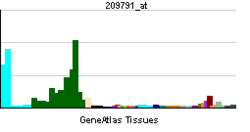PADI2
| View/Edit Human | View/Edit Mouse |
Protein-arginine deiminase type-2 is an enzyme that in humans is encoded by the PADI2 gene.[3][4]
This gene encodes a member of the peptidyl arginine deiminase family of enzymes, which catalyze the post-translational deimination of proteins by converting arginine residues into citrullines in the presence of calcium ions. The family members have distinct substrate specificities and tissue-specific expression patterns. The type II enzyme is the most widely expressed family member. Known substrates for this enzyme include myelin basic protein in the central nervous system and vimentin in skeletal muscle and macrophages.
This enzyme is thought to play a role in the onset and progression of neurodegenerative human disorders, including Alzheimer disease and multiple sclerosis, and it has also been implicated in glaucoma pathogenesis. This gene exists in a cluster with four other paralogous genes.[4]
References
- ↑ "Human PubMed Reference:".
- ↑ "Mouse PubMed Reference:".
- ↑ Watanabe K, Senshu T (Oct 1989). "Isolation and characterization of cDNA clones encoding rat skeletal muscle peptidylarginine deiminase". J Biol Chem. 264 (26): 15255–60. PMID 2768262.
- 1 2 "Entrez Gene: PADI2 peptidyl arginine deiminase, type II".
Further reading
- Vossenaar ER, Zendman AJ, van Venrooij WJ, Pruijn GJ (2004). "PAD, a growing family of citrullinating enzymes: genes, features and involvement in disease.". BioEssays. 25 (11): 1106–18. doi:10.1002/bies.10357. PMID 14579251.
- Chavanas S, Méchin MC, Nachat R, et al. (2006). "Peptidylarginine deiminases and deimination in biology and pathology: relevance to skin homeostasis.". J. Dermatol. Sci. 44 (2): 63–72. doi:10.1016/j.jdermsci.2006.07.004. PMID 16973334.
- Moscarello MA, Mastronardi FG, Wood DD (2007). "The role of citrullinated proteins suggests a novel mechanism in the pathogenesis of multiple sclerosis.". Neurochem. Res. 32 (2): 251–6. doi:10.1007/s11064-006-9144-5. PMC 1794624
 . PMID 17031564.
. PMID 17031564. - Nagase T, Ishikawa K, Suyama M, et al. (1999). "Prediction of the coding sequences of unidentified human genes. XIII. The complete sequences of 100 new cDNA clones from brain which code for large proteins in vitro.". DNA Res. 6 (1): 63–70. doi:10.1093/dnares/6.1.63. PMID 10231032.
- Venter JC, Adams MD, Myers EW, et al. (2001). "The sequence of the human genome.". Science. 291 (5507): 1304–51. doi:10.1126/science.1058040. PMID 11181995.
- Ishigami A, Ohsawa T, Asaga H, et al. (2002). "Human peptidylarginine deiminase type II: molecular cloning, gene organization, and expression in human skin.". Arch. Biochem. Biophys. 407 (1): 25–31. doi:10.1016/S0003-9861(02)00516-7. PMID 12392711.
- Strausberg RL, Feingold EA, Grouse LH, et al. (2003). "Generation and initial analysis of more than 15,000 full-length human and mouse cDNA sequences.". Proc. Natl. Acad. Sci. U.S.A. 99 (26): 16899–903. doi:10.1073/pnas.242603899. PMC 139241
 . PMID 12477932.
. PMID 12477932. - Chavanas S, Méchin MC, Takahara H, et al. (2004). "Comparative analysis of the mouse and human peptidylarginine deiminase gene clusters reveals highly conserved non-coding segments and a new human gene, PADI6.". Gene. 330: 19–27. doi:10.1016/j.gene.2003.12.038. PMID 15087120.
- Sambandam T, Belousova M, Accaviti-Loper MA, et al. (2005). "Increased peptidylarginine deiminase type II in hypoxic astrocytes.". Biochem. Biophys. Res. Commun. 325 (4): 1324–9. doi:10.1016/j.bbrc.2004.10.173. PMID 15555572.
- Nakayama-Hamada M, Suzuki A, Kubota K, et al. (2005). "Comparison of enzymatic properties between hPADI2 and hPADI4.". Biochem. Biophys. Res. Commun. 327 (1): 192–200. doi:10.1016/j.bbrc.2004.11.152. PMID 15629448.
- Ishigami A, Ohsawa T, Hiratsuka M, et al. (2005). "Abnormal accumulation of citrullinated proteins catalyzed by peptidylarginine deiminase in hippocampal extracts from patients with Alzheimer's disease.". J. Neurosci. Res. 80 (1): 120–8. doi:10.1002/jnr.20431. PMID 15704193.
- Gregory SG, Barlow KF, McLay KE, et al. (2006). "The DNA sequence and biological annotation of human chromosome 1.". Nature. 441 (7091): 315–21. doi:10.1038/nature04727. PMID 16710414.
- Bhattacharya SK, Crabb JS, Bonilha VL, et al. (2006). "Proteomics implicates peptidyl arginine deiminase 2 and optic nerve citrullination in glaucoma pathogenesis.". Invest. Ophthalmol. Vis. Sci. 47 (6): 2508–14. doi:10.1167/iovs.05-1499. PMID 16723463.
- Mastronardi FG, Noor A, Wood DD, et al. (2007). "Peptidyl argininedeiminase 2 CpG island in multiple sclerosis white matter is hypomethylated.". J. Neurosci. Res. 85 (9): 2006–16. doi:10.1002/jnr.21329. PMID 17469138.
